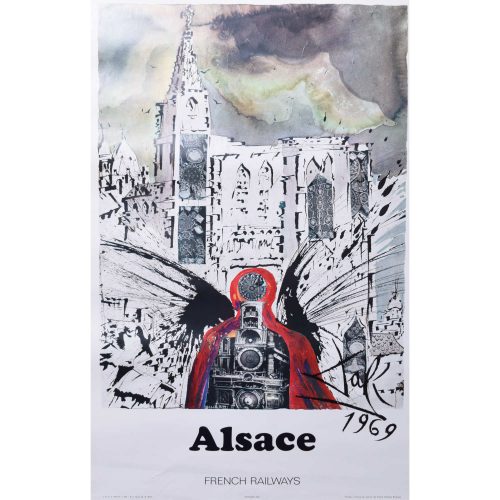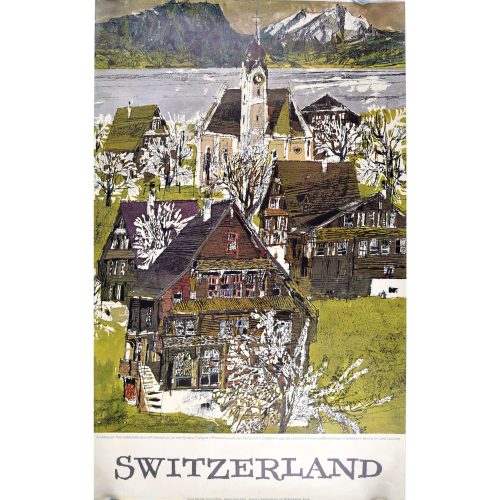-
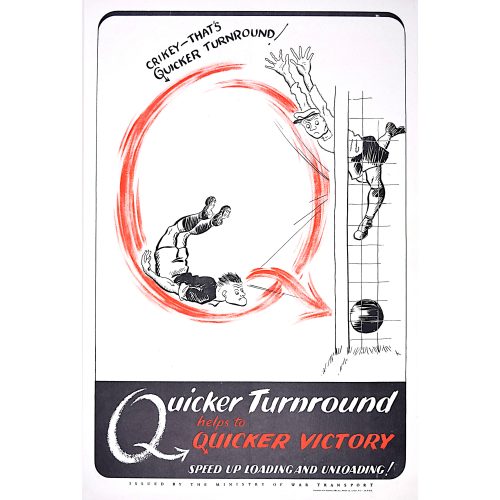
Ministry of War Transport Quicker Turnaround Helps to Quicker Victory - Football
Original vintage poster c. 1940 30x20" Printed by H M Stationery Office by J Weiner Ltd London WC1 Provenance, the Bendell Bayley studio. During the war, every aspect of life had its own Government influence. Here transport of war materiel is being managed and faster re-loading of transport is encouraged to improve efficiency. Condition: Good. Backed to linen. If you are interested email info@manningfineart.co.uk or call us on 07929 749056. -
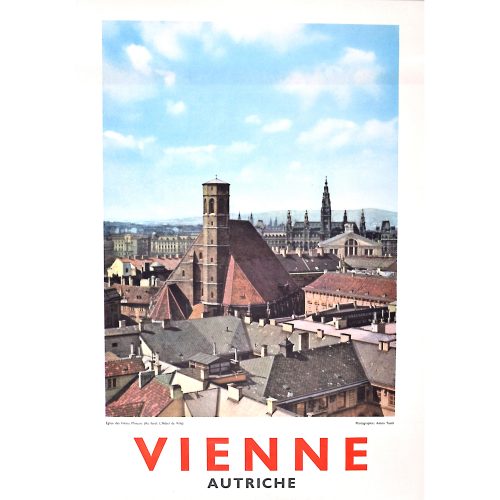
Anton Tusch (photographer) Eglise des Freres Mineurs, Vienna, Austria / Osterreich
Original poster c. 1950s 61x43cm If you are interested email info@manningfineart.co.uk or call us on 07929 749056. Condition: Generally very good. -
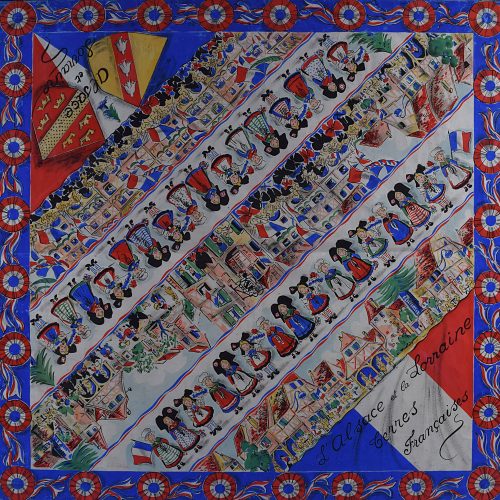
Design for Bianchi Ferier, Lyon for a silk scarf 5 March 1945
Gouache, pen and ink 78cm x 76cm Provenance: The Bianchi Ferrier archive sale at Christies On 9 February 1945 the 'Colmar Pocket' was finally cleared of Germans - a process that had started in November 1944 - and the province of Alsace changed hands between France and Germany for the fourth time in 75 years. Happily in the succeeding 75 years Alsace has not changed ownership. If you are interested email info@manningfineart.co.uk or call us on 07929 749056. Condition: Good. -
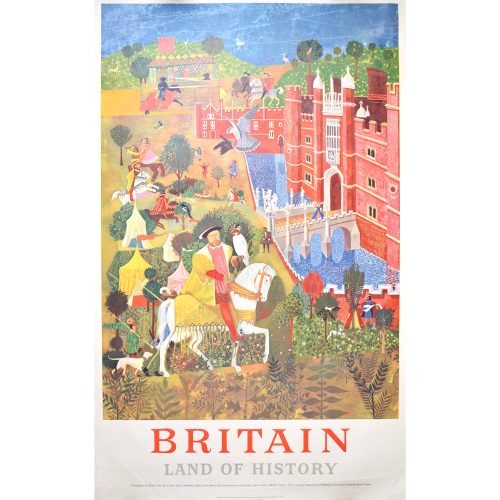
Britain Land of History Original Vintage Poster c. 1960
Published by the British Travel and Holidays Association and printed in Great Britain by Harrison and Sons Ltd 59/60.14 'Throughout the British Isles can be seen many interesting castles, royal palaces and country houses which have played a part in Britain's history. This is an artist's impression of Hampton Court Palace beside the River Thames.' If you are interested email info@manningfineart.co.uk or call us on 07929 749056. Condition: Generally good condition, a few very short repaired edge tears and the odd marginal crease. Mounted and framed the edge tears will not be visible. -
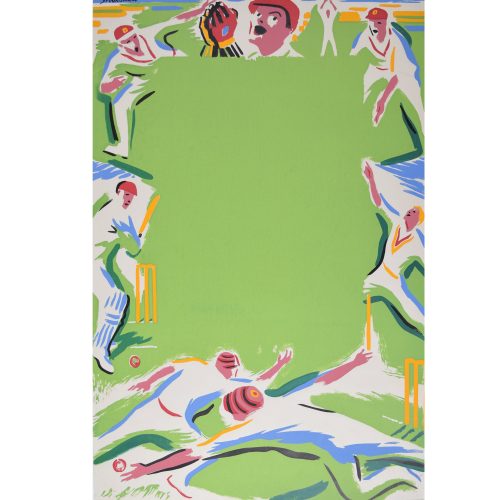
Percy Drake Brookshaw (1907-1993) Cricket
Original coach poster Lithograph c. 1950s 76x50cm A poster for advertising details of coaches to cricket matches such as The Ashes or other Test Matches. Brookshaw was born in Southwark, in London, and educated at the Central School of Arts and Crafts. He was a particularly accomplished lithographer, skilled also as a painter in both oil and watercolour. Identifying the former talent, F Gregory Brown - the poster and textile designer - encouraged him to become an illustrator and poster designer. Producing posters for London Transport and Shell, inter alia, between 1928 and 1958, many of his posters depict sporting events. His two posters for the annual University Boat Race are well known and highly sought after, and his wonderful posters often evoke a feeling of movement, whether rowers straining on their oars, or horses or greyhounds racing. If you are interested email info@manningfineart.co.uk or call us on 07929 749056. Conditon: Generally very good, a few short edge tears and soft creases, see photograph. -
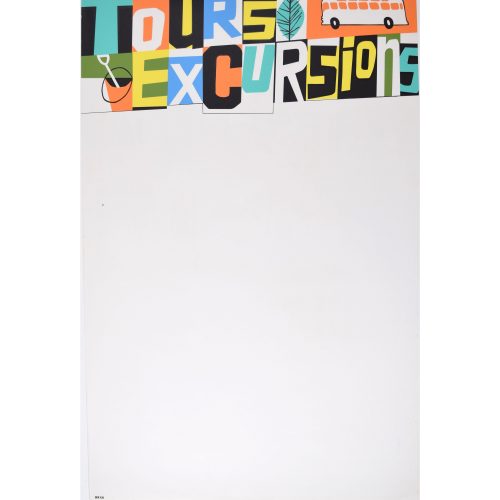
Anonymous Tours and Excursions
Original Coach Poster 75x50cm Cool and crazy mid-century lettering. Poster with area for completion with details of a coach tour. If you are interested email info@manningfineart.co.uk or call us on 07929 749056. Condition: Excellent. -
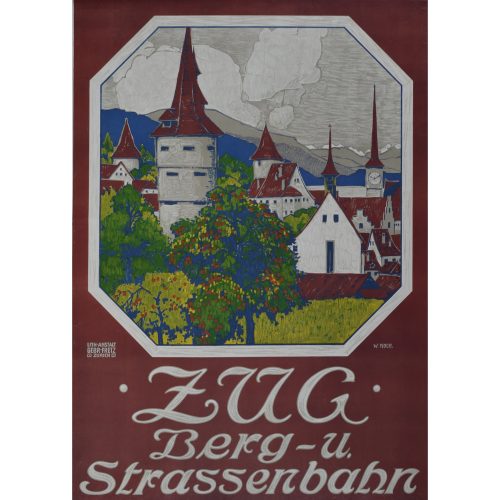
Walther Koch (1875-1915) Zug Berg und Strassenbahn
Original lithographic poster (1914) 40x30" Printed in Zurich by Anstalt Gebr Fretz If you are interested email info@manningfineart.co.uk or call us on 07929 749056. Condition: Excellent. -
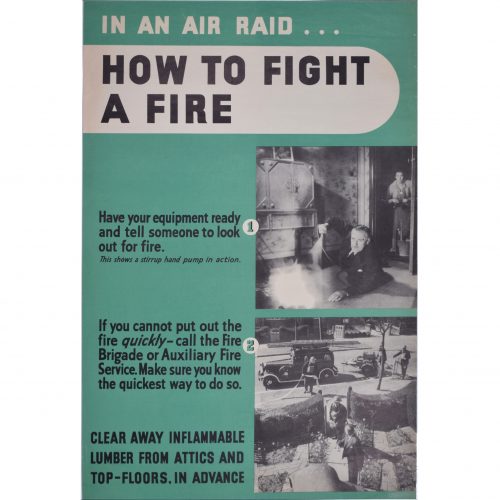
In an Air Raid... How to fight a fire World War 2 Vintage Poster
30x20" [HMSO, London] nd. np. A householder, dressed in a tie, is shown spraying water onto a fire, as his wife pumps water out of a bucket using a stirrup hand pump. Instructions are given to call the Fire Brigade if the fire cannot be extinguished. Householders are warned to clear away inflammable lumber from attics and top-floors, in advance. If you are interested email info@manningfineart.co.uk or call us on 07929 749056. Condition: Generally excellent, slight edge wear as usual. -
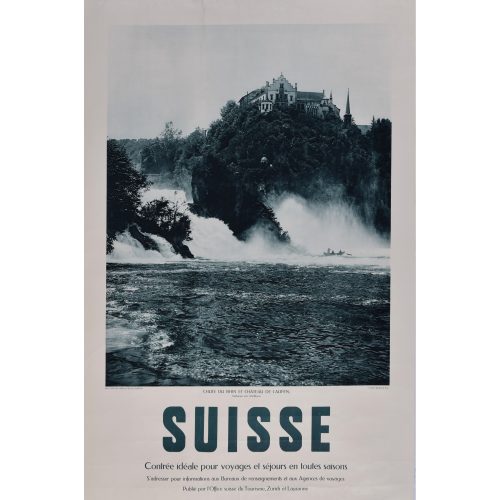
Suisse Chutes du Rhin
Original lithographic poster (1925) 40x25" If you are interested email info@manningfineart.co.uk or call us on 07929 749056. Condition: Generally good, a little edge wear. -
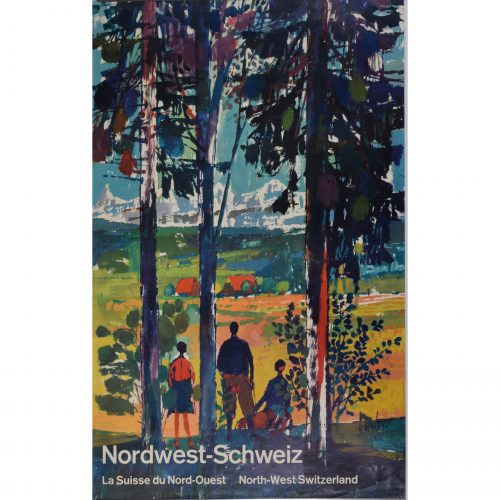
Hugo Wetli (1916-1972) Nordwest-Schweiz North-West Switzerland La Suisse du Nord-Ouest
Original Poster c. 1960s If you are interested email info@manningfineart.co.uk or call us on 07929 749056. Condition: Excellent. -

Hugo Wetli (1916-1972) Ticino - Come and Paint Ticino Contest for your holidays 1964
Original Poster 1964 If you are interested email info@manningfineart.co.uk or call us on 07929 749056. Condition: Excellent. -
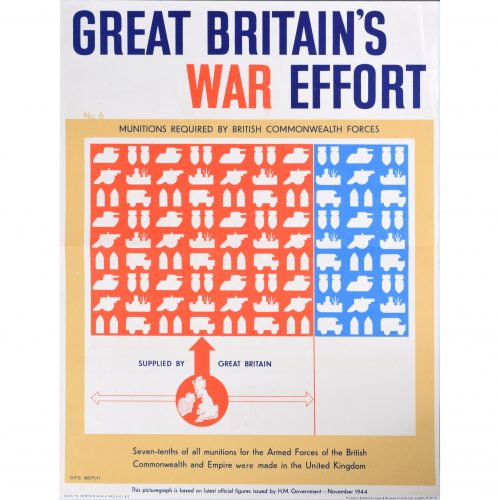
Printed by Lowe & Brydone Printers (1944)
Great Britain's War Effort No. 6 (Munitions)
50x37cm "Seven-tenths of all munitions for the Armed Forces of the British Commonwealth and Empire were made in the United Kingdom. This picturegraph is based on latest official figures issued by HM Government November 1944." The population of the Empire had to be persuaded that Britain was pulling her weight in World War 2. Bu this poster and others similar could the message be put across. The fine stylised tanks, bombs, ships, guns and other vehicles are stacked up on the left-hand side showing the British contribution. If you are interested email info@manningfineart.co.uk or call us on 07929 749056. Condition: Folds as issued, otherwise generally excellent. -
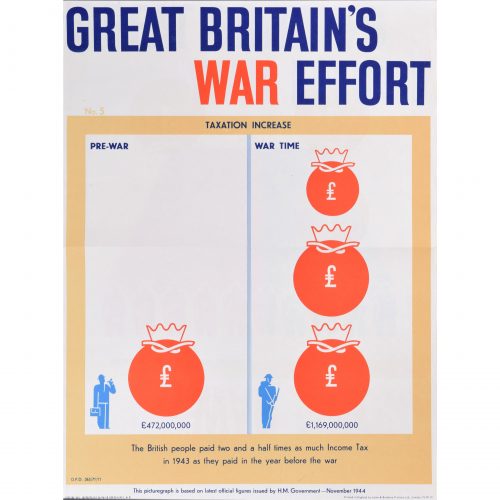
Printed by Lowe & Brydone Printers (1944)
Great Britain's War Effort No. 5 (Taxation)
50x37cm "The British people paid two and a half times as much Income Tax in 1943 as they paid in the year before the war. This picturegraph is based on latest official figures issued by HM Government November 1944." Pre-war taxation: £472,000,000 War-time £1,169,000,000 The population of the Empire had to be persuaded that Britain was pulling her weight in World War 2. By this poster and others similar could the message be put across. If you are interested email info@manningfineart.co.uk or call us on 07929 749056. Condition: Folds as issued, otherwise generally excellent. -
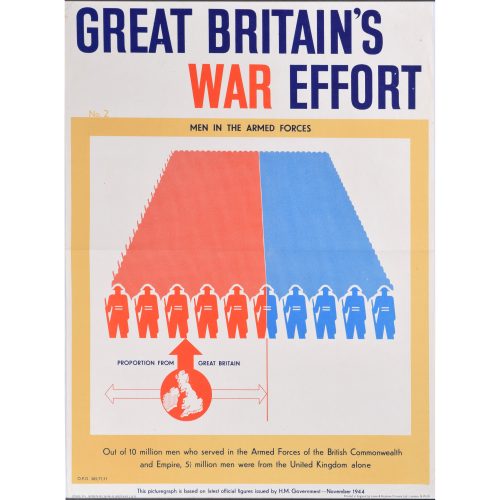
Printed by Lowe & Brydone Printers (1944)
Great Britain's War Effort No. 2 (Men in the armed forces)
50x37cm "Of the ten million men who served in the Commonwealth's Armed Forces five-and-a-half million men were from the United Kingdom alone. This picturegraph is based on latest official figures issued by HM Government November 1944." The population of the Empire had to be persuaded that Britain was pulling her weight in World War 2. By this poster and others similar could the message be put across. If you are interested email info@manningfineart.co.uk or call us on 07929 749056. Condition: Folds as issued, otherwise generally excellent. -
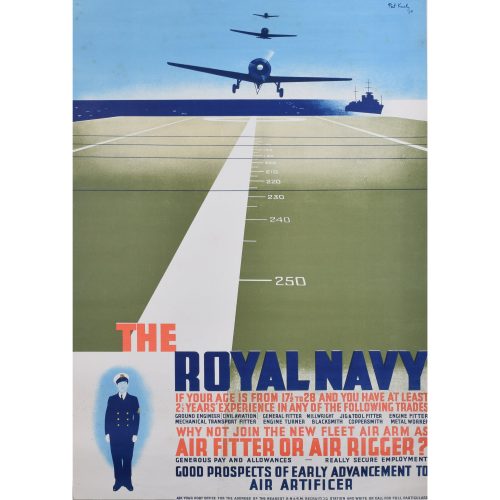
Pat Keely (d. 1970) The Royal Navy
75x51cm Original lithographic poster 1939 Printed for HMSO by Vincent Brooks, Day & Son Ltd, London If your age is from 17 1/2 to 28 and you have at least 2 1/2 years' experience in any of the following trades: Ground Engineer (Civil Aviation) General Fitter Millwright Jig & Tool Fitter etc. Why not join the new Fleet Air Arm as Air Fitter or Air Rigger Generous Pay and Allowances - Really Secure Employment Good Prospects of Early Advancement to Air Artificer Little is known of the life of the rather private Pat Keely, a prolific and excellent designer of posters. He designed the World Scout Jamboree 4d stamp in 1957 and produced many posters for the British Government. In this excellent poster three aeroplanes are seen landing on the deck of an aircraft carrier; although somewhat stylised they are likely to be the Blackburn Skua. If you are interested email info@manningfineart.co.uk or call us on 07929 749056. Condition: Generally very good. -
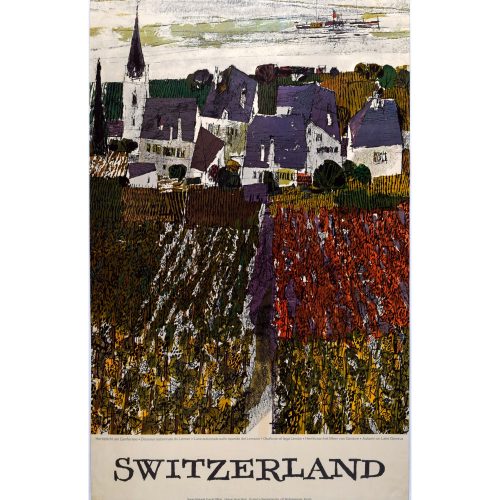
Hugo Wetli (1916-1972) Autumn on Lake Geneva Herbst am Genfersee Douceur automnale du Léman
Original Poster c. 1960s 40x25" If you are interested email info@manningfineart.co.uk or call us on 07929 749056. Condition: Pinholes to corners, some soft creases, not backed, generally good. -
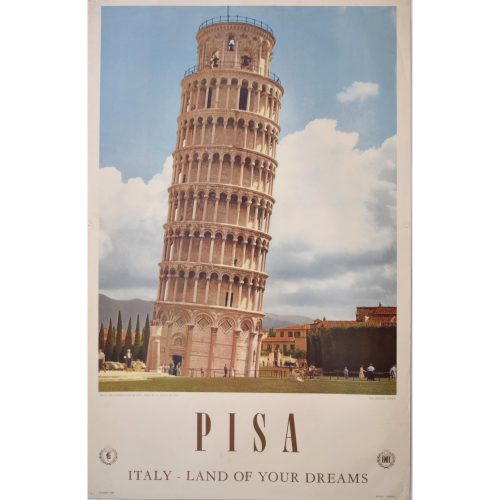
Ente Nazionale Italiano per il Turismo (The Italian Government Tourist Board)
PISA - ITALY - LAND OF YOUR DREAMS
Lithographic poster 101 x 63.5 cm If you are interested, please email info@manningfineart.co.uk or call us on 07929 749056. Condition: Good. Pin-holes to corners; not backed. -

Lance Cottermole A Map of Northumberland & Durham, UK
1949 Lithographic poster Published for Railway Executive 102x63cm If you are interested email info@manningfineart.co.uk or call us on 07929 749056. Condition: Good. Backed to linen, repaired tear, presents very well. -
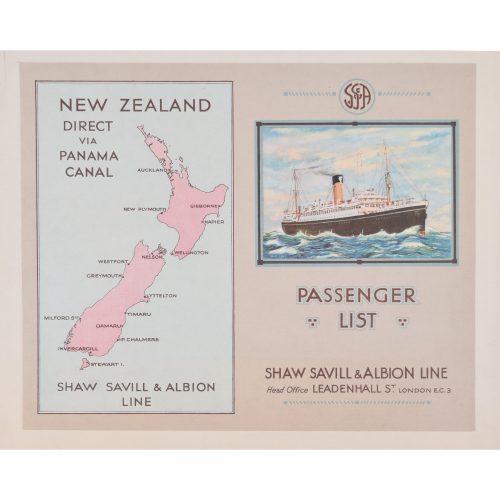
A E Agar (artist) Original passenger list brochure for Shaw Savill Albion Line, c. 1940s or 1950s.
24x34cm (approx) Provenance: the artist's estate As new, unissued printer's proof. Could be trimmed to the brochure size if desired. Fine image of ocean liner to front cover, map - via Panama Canal - to back cover. From the great age of Ocean Liners. If you are interested email info@manningfineart.co.uk or call us on 07929 749056. Condition: Excellent. -

Claude Harrison Shell Guide to Westmoreland
Original poster for Shell Oil c. 1960s 76x51cm Shell commissioned a series of posters to go with their County Guide books, and they commissioned paintings by the leading artists of the day. Claude Harrison studied at Preston College of Art (1939-1941) and Liverpool College of Art (1941-2) after which he enlisted in the RAF for five years. On his return, he continued studies at Royal College of Art (1947-50). Harrison’s work consisted of murals, portraits, conversation pieces and mystical figure compositions - which are seen here in the Westmoreland poster. He was a member of the Royal Academy and his work has regularly been exhibited in the annual summer exhibition. If you are interested email info@manningfineart.co.uk or call us on 07929 749056. Condition: Fair. Short edge tears which are hidden by mount/mat; some age toning. Metal hanger removed to allow matting. See photograph for more information -
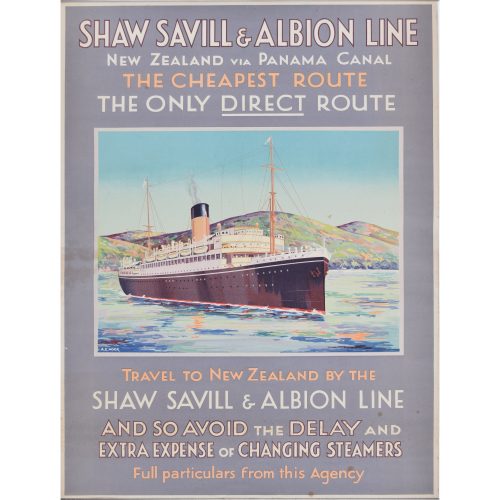
A E Agar (artist) Original advertising poster for Shaw Savill Albion Line, c. 1940s or 1950s.
51x38cm Provenance: the artist's estate Fine image of ocean liner. From the great age of Ocean Liners. If you are interested email info@manningfineart.co.uk or call us on 07929 749056. Condition: Good. -
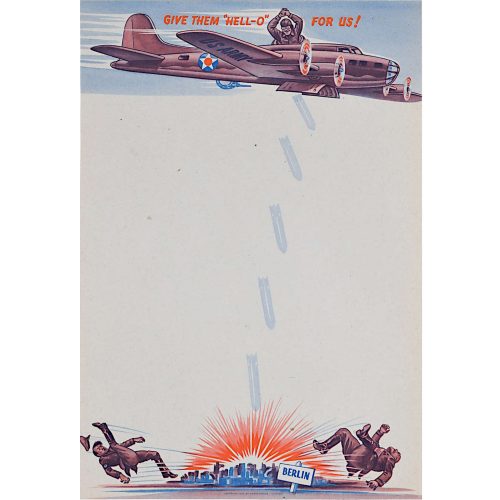
Porto-Service, Chicago Give them "Hell-o from us!"
Lithograph 26.5x18cm 1942 What better writing paper to send to a serving serviceman than one encouraging him to fight. Porto-Service of Chicago published a series of illustrated writing resources for sweethearts and friends to write to their brave servicemen, in this case in a four-engined bomber over Berlin. Lavishly produced and printed, the Americans brought some much-needed colour and glamour to dull war-torn Britain. If you are interested email info@manningfineart.co.uk or call us on 07929 749056. Condition: Very good. -
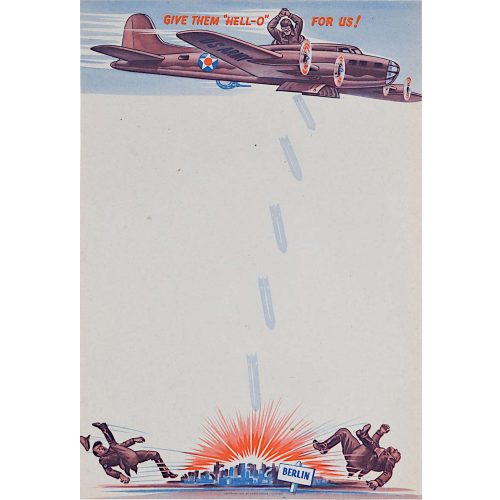
Porto-Service, Chicago Keep 'em Running Right off the Map!
Lithograph 26.5x18cm 1942 What better writing paper to send to a serving serviceman than that encouraging him to fight. Porto-Service of Chicago published a series of illustrated writing resources for sweethearts and friends to write to their brave servicemen, in this case teasing the three Axis dictators. Lavishly produced and printed, the Americans brought some much-needed colour and glamour to dull war-torn Britain. If you are interested email info@manningfineart.co.uk or call us on 07929 749056. Condition: Very good. -
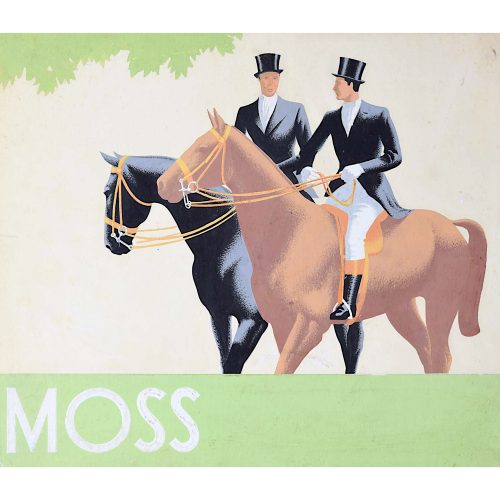
Anonymous Moss Gouache original design for poster
30x33cm c. 1930s Sadly the artist is unknown, but this rather good example of commercial artwork cleverly places the images of two impeccably dressed horse riders upon tremendously handsome horses. If you are interested email info@manningfineart.co.uk or call us on 07929 749056. Condition: Generally good condition, a few old losses as may be seen in picture. -

Hans Schleger 'Zero' (1898-1976) London Transport Coach Stop Request Poster
Screenprint poster c. 1970 16x18 cm Printed for London Transport These posters were designed to be used as temporary stops when the usual stop required amendment for instance owing to road works or similar events. Printed on paper they were designed to be posted up at the alternative site, possibly over a different sort of stop (bus stop, coach stop, request stop, etc.). Working with Edward Johnson's special typeface created for London Transport, Hans Schleger - or Zero as he signed himself - adopted the famous roundel used by London Underground for use at Bus Stops. Born in Germany, Schleger was an influential graphic designer. After serving during the First World War, he studied at the Berlin Kunstgewerbeschule, being taught by Emil Orlik. The same year Walter Gropius founded the Bauhaus at Weimar and Schleger learned the same principles of breaking down the barriers between architecture, design, fine art and craft. A firm believer in the Bauhaus principles of simplicity in design and reduction to essentials, these may be seen in the clean lines of the roundel. In 1924 he moved to New York, applying Modernism to American advertising, and then returned to Berlin in 1929 working for the British advertising agency Crawfords, where he met Edward McKnight Kauffer who introduced him to Jack Beddington the head of advertising at Shell Mex BP. Following the rise of Hitler he emigrated to London where he produced a series of posters for Shell Mex. During World War 2 he worked for the British Government. In 1950 he taught at the Chicago Institute of Design which had been founded by Moholy-Nagy, thus bringing him back to his Bauhaus origins. Subsequently he designed the trademarks of John Lewis Partnership, Penguin, Deutsche Bank and the Edinburgh Festival. If you are interested email info@manningfineart.co.uk or call us on 07929 749056. Condition: In unissued condition. Mounted. -

Hans Schleger 'Zero' (1898-1976) London Transport Bus Stop Poster
Screenprint poster c. 1970 16x17.8 cm Printed for London Transport These posters were designed to be used as temporary stops when the usual stop required amendment for instance owing to road works or similar events. Printed on paper they were designed to be posted up at the alternative site, possibly over a different sort of stop (bus stop, coach stop, request stop, etc.). Working with Edward Johnson's special typeface created for London Transport, Hans Schleger - or Zero as he signed himself - adopted the famous roundel used by London Underground for use at Bus Stops. Born in Germany, Schleger was an influential graphic designer. After serving during the First World War, he studied at the Berlin Kunstgewerbeschule, being taught by Emil Orlik. The same year Walter Gropius founded the Bauhaus at Weimar and Schleger learned the same principles of breaking down the barriers between architecture, design, fine art and craft. A firm believer in the Bauhaus principles of simplicity in design and reduction to essentials, these may be seen in the clean lines of the roundel. In 1924 he moved to New York, applying Modernism to American advertising, and then returned to Berlin in 1929 working for the British advertising agency Crawfords, where he met Edward McKnight Kauffer who introduced him to Jack Beddington the head of advertising at Shell Mex BP. Following the rise of Hitler he emigrated to London where he produced a series of posters for Shell Mex. During World War 2 he worked for the British Government. In 1950 he taught at the Chicago Institute of Design which had been founded by Moholy-Nagy, thus bringing him back to his Bauhaus origins. Subsequently he designed the trademarks of John Lewis Partnership, Penguin, Deutsche Bank and the Edinburgh Festival. If you are interested email info@manningfineart.co.uk or call us on 07929 749056. Condition: In unissued condition. Mounted. -
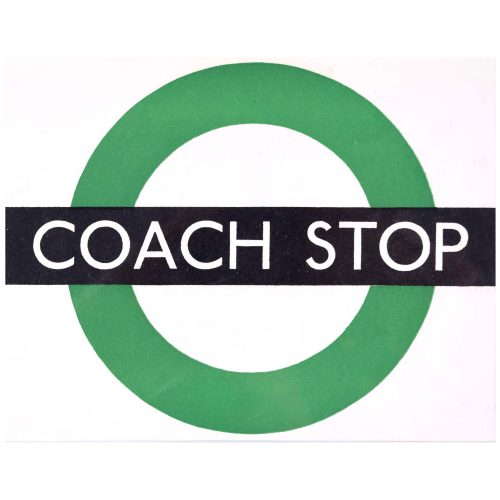
Hans Schleger 'Zero' (1898-1976) London Transport Coach Stop Poster
Screenprint poster c. 1970 16x20 cm Printed for London Transport These posters were designed to be used as temporary stops when the usual stop required amendment for instance owing to road works or similar events. Printed on paper they were designed to be posted up at the alternative site, possibly over a different sort of stop (bus stop, coach stop, request stop, etc.). Working with Edward Johnson's special typeface created for London Transport, Hans Schleger - or Zero as he signed himself - adopted the famous roundel used by London Underground for use at Bus Stops. Born in Germany, Schleger was an influential graphic designer. After serving during the First World War, he studied at the Berlin Kunstgewerbeschule, being taught by Emil Orlik. The same year Walter Gropius founded the Bauhaus at Weimar and Schleger learned the same principles of breaking down the barriers between architecture, design, fine art and craft. A firm believer in the Bauhaus principles of simplicity in design and reduction to essentials, these may be seen in the clean lines of the roundel. In 1924 he moved to New York, applying Modernism to American advertising, and then returned to Berlin in 1929 working for the British advertising agency Crawfords, where he met Edward McKnight Kauffer who introduced him to Jack Beddington the head of advertising at Shell Mex BP. Following the rise of Hitler he emigrated to London where he produced a series of posters for Shell Mex. During World War 2 he worked for the British Government. In 1950 he taught at the Chicago Institute of Design which had been founded by Moholy-Nagy, thus bringing him back to his Bauhaus origins. Subsequently he designed the trademarks of John Lewis Partnership, Penguin, Deutsche Bank and the Edinburgh Festival. If you are interested email info@manningfineart.co.uk or call us on 07929 749056. Condition: In unissued condition. Mounted. -
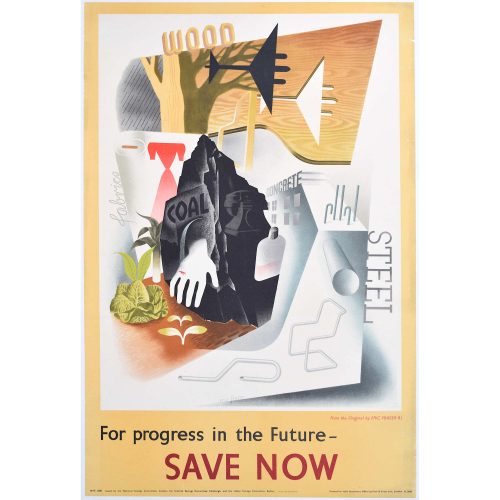
Eric Fraser For Progress in the Future Save Now
75x51cm Original Vintage Poster Issued by the National Savings Committee If you are interested email info@manningfineart.co.uk or call us on 07929 749056. Condition: Backed to linen, small edge tears to right side as visibile in image. -
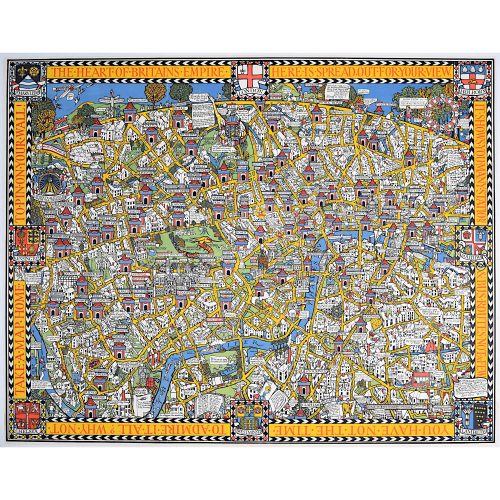
Macdonald (Max) Gill (1884-1947) Wonderground Map of London (c. 1924, after 1914 original edition)
Lithographic poster 75x94cm In the present work, in the top left-hand corner it reads 'On to Wembley' making reference to the British Empire Exhibition of 1924. Gill's original 1914 poster was hugely popular and reprinted with updates to feature topical events. Born in Brighton, Max Gill was the second son in a family of thirteen children; his elder brother was Eric Gill, the typographer and sculptor. Both Gills exhibited significant talent at a young age. Max Gill’s first map was made for a school map-drawing project following which he entered maps into competitions in boys’ magazines. In 1903 he moved to London as assistant to the ecclesiastical architects Sir Charles Nicholson and Hubert Corlette. By 1908 he had started his own architectural practice, but in 1909 Sir Edwin Lutyens commissioned Gill to paint a “wind dial” map for Nashdom, a large house in Buckinghamshire. The wind dial was set over the fireplace and attached to a weather vane on the roof, allowing the occupant to know the direction of the wind from the comfort of the house. He produced seven further wind dials including for Lutyens’s Lindisfarne Castle and for the Allhusen Room at Trinity College, Cambridge. Although he continued to practice as an architect, Frank Pick commissioned him to create seven pictorial maps for the Underground, the first being the famous 1913 ‘Wonderground Map of London Town.’ In 1917 he joined the Imperial War Graves Commission’s headstone design committee, designing the typeface and regimental badges. Gill’s memorials for the fallen in the First World War include for Balliol and Worcester Colleges and Christ Church in Oxford. During the 1920s and 30s Gill undertook many commercial commissions for advertising materials. The Empire Marketing Board and Shell-Mex as well as further maps for the Underground. He designed in 1922 the first diagrammatic map of the Underground which provided the foundation for Beck’s more famous map. By the 1930s his major works were murals. Those of the Arctic and Antarctic on the ceilings of the Scott Polar Research Institute in Cambridge are beautiful, but the most impressive is the map of the North Atlantic in the first-class dining room of the Queen Mary (maiden voyage: 1936, now moored at Long Beach, California). During the Second World War he created a series of propaganda posters for the Ministry of Information. -

Nat Harrison
Accidents Sometimes Happen... Work Carefully Avoid Scrap
Original poster c. 1943 Printed for HMSO by J Weiner Ltd, London for the Ministry of Aircraft Production Produced by the Bayly-Souster advertising agency, Fleet Street Provenance the estate of Ernest Bendell-Bayly The waste-not-want-not campaign of World War 2 in the UK had to tackle waste at all levels. Here workers in aircraft factories are encouraged to work carefully in order to avoid creating products that had to be scrapped. Not only were the raw materials scrapped, but also the valuable hours of workers' time involved. When Lord Beaverbrook commenced his term as Minister of Aircraft Production in May 1940 it was an industry beset with problems. Aircraft parts were produced in sufficient numbers, but assembly into flyable aircraft proved more challenging – the Castle Bromwich Spitfire factory had not produced a single completed aircraft by this point. Moreover the RAF central depots had large supplies of aircraft that had not been issued to squadrons. Once this was all brought under Beaverbrook’s control, aircraft production increased rapidly. During the Battle of Britain, the British production of fighter aircraft was two-and-a-half times that of Germany. Britain had 644 operable fighters at the start of July 1940 – when the Battle of Britain began – against the German 725. By the end of October 1940, when the German offensive finished, British fighter aircraft had – despite significant losses – increased to 732 whilst the Germans were left with just 275. To achieve this great productivity increase the Ministry was run on informal grounds; few notes were kept; staff members had few formal roles. Essential to the success were motivational posters in the aircraft factories. If you are interested email info@manningfineart.co.uk or call us on 07929 749056. -
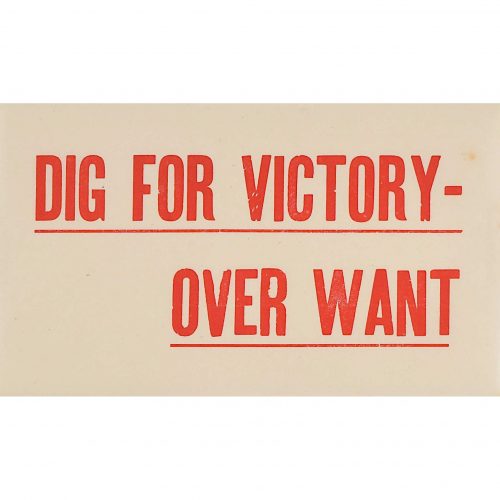
Dig for Victory over Want World War II public information
11x18cm for His Majesty's Stationery Office HMSO On gummed paper Printed on gummed paper, this was designed to be widely propagated, so that the public information message would not get lost. With food having to be shipped over the U-Boat infested Atlantic putting sailors' lives and ships at risk, every scrap of food that could be grown at home saved lives and allowed munitions to be transported instead. Therefore the Government started a large public information campaign to Dig for Victory - encouraging people to dig up their gardens and grow food. If you are interested email info@manningfineart.co.uk or call us on 07929 749056. -
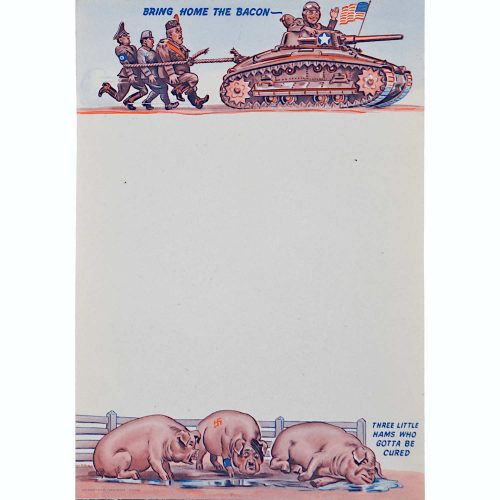
Porto-Service, Chicago Bring Home the Bacon - three little hams who gotta be cured!
Lithograph 26.5x18cm 1942 What better writing paper to send to a serving serviceman than that encouraging him to fight. Porto-Service of Chicago published a series of illustrated writing resources for sweethearts and friends to write to their brave servicemen, in this case teasing the three Axis dictators. Lavishly produced and printed, the Americans brought some much-needed colour and glamour to dull war-torn Britain. If you are interested email info@manningfineart.co.uk or call us on 07929 749056. -
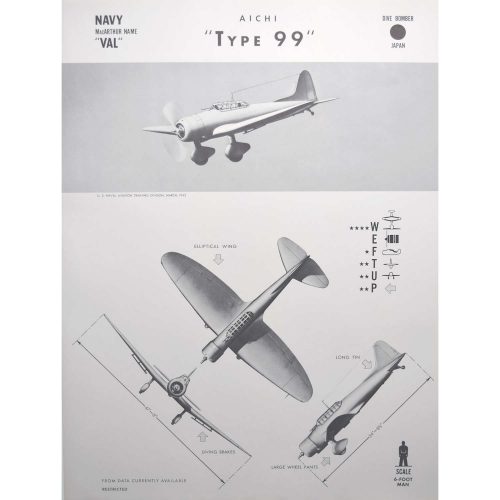
1942 MacArthur name "Val" Aichi "Type 99"
World War II Japanese dive bomber plane
Original aeroplane identification poster, 1942 63 x 47 cm A particularly unusual style of aeroplane identification poster, owing to the very arty images. Most such posters rely on very plain silhouettes, this series - and we have many in this series - have a much more arty approach to the task with shading and an interesting angle view. The Aichi D3A Type 99 Carrier Bomber (Allied reporting name "Val") was a World War II carrier-borne dive bomber. It was the primary dive bomber of the Imperial Japanese Navy (IJN) and was involved in almost all IJN actions, including the attack on Pearl Harbor. The Aichi D3A was the first Japanese aircraft to bomb American targets in the war, commencing with Pearl Harbor and U.S. bases in the Philippines, such as the Clark Air Force Base. They sank more Allied warships than any other Axis aircraft. If you'd like to know more, please email info@manningfineart.co.uk or call us on 07929 749056. -
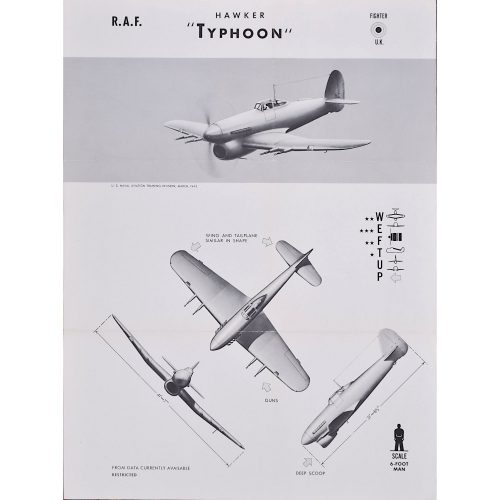
US Naval Aviation Training Division
RAF Hawker Typhoon World War 2 US airplane
Original aeroplane identification poster, 1942 63x47cm A particularly unusual style of aeroplane identification poster, owing to the very arty images. Most such posters rely on very plain silhouettes, this series - and we have several in this series (click here) - have a much more arty approach to the task with shading and an interesting angle view. The Typhoon is a single-seat fighter-bomber nicknamed the 'Tiffy'. Designed as a replacement for the Hawker Hurricane it never completely satisfied this expectation. However it was the only RAF fighter capable of catching the Fw 190 at low altitudes when the latter came into service in 1941. It became one of the most effective ground-attack aircraft of the Second World War. 3317 were produced and only one complete Typhoon still exists which belongs to the Royal Air Force Museum in Hendon. If you are interested email info@manningfineart.co.uk or call us on 07929 749056. -

US Naval Aviation Training Division
RAF Bristol Beaufighter World War 2 US airplane
Aeroplane identification poster, 1942 63 x 47 cm A particularly unusual style of aeroplane identification poster, owing to the very arty images. Most such posters rely on very plain silhouettes, this series - and we have several in this series (click here) - have a much more arty approach to the task with shading and an interesting angle view. The Beaufighter is a multi-role aircraft conceived originally as a heavy fighter variant of the Bristol Beaufort. As an effective night fighter it came into service during the Battle of Britain, having the space for radar it became a highly effective night fighter. The de Havilland Mosquito, being somewhat faster, took over in the latter part of 1942. The Beaufighter saw service in all theatres during World War II, serving through to the Greek civil war in 1946. 5,928 were built but no flying examples exist today, although The Fighter Collection at Duxford is currently restoring an aircraft (made from multiple aircraft). If you are interested, please email info@manningfineart.co.uk or call us on 07929 749056. -
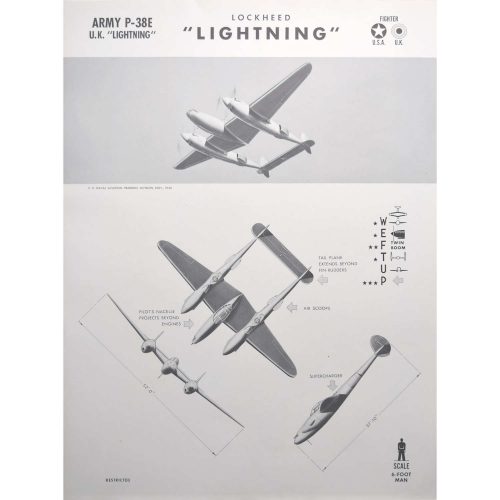
Army P-38E Lockheed "Lightning"
Aeroplane identification poster, published 1942 63 x 47 cm A particularly unusual style of aeroplane identification poster, owing to the very arty images. Most such posters rely on very plain silhouettes, this series - and we have several in this series; view them here - have a much more arty approach to the task with shading and an interesting angle view. The Lockheed P-38 Lightning was an American single-seated, twin piston-engined fighter aircraft that was used during World War II. The Lightning was originally designed as a bomber-interceptor and was never intended to be a fighter. Weight was kept to a minimum and it was far more advanced and faster than its U.S. counterparts, the Bell P-39 Airacobra and Curtiss P-40 Warhawk (original Airacobra and Warhawk posters from the same 1942 series are also available in our storefront). It caught the attention of the US Army Air Corps (USAAC) very quickly. The Lightning shot down more Japanese aeroplanes than any other fighter during World War II. When first introduced in 1939, the Lightning was able to fly a steady course at 413 mph (665 km/h), making it the fastest production aeroplane in the world. It remained one of the fastest climbers right up to the end of the WW II. Condition: generally very good. If you are interested, please email info@manningfineart.co.uk or call us on 07929 749056. -
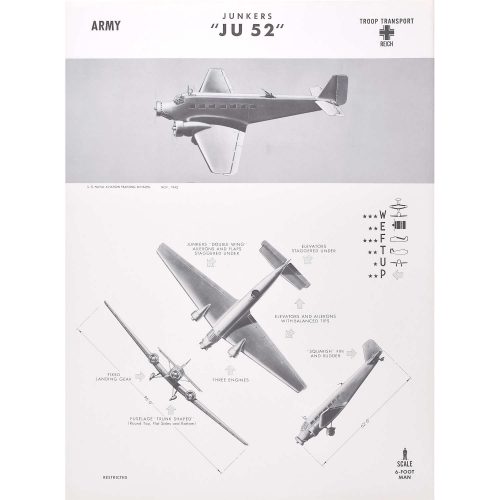
Junkers "JU 52"
Aeroplane identification poster, published 1942 63 x 47 cm A particularly unusual style of aeroplane identification poster, owing to the very arty images. Most such posters rely on very plain silhouettes, this series - and we have several in this series; view them here - have a much more arty approach to the task with shading and an interesting angle view. The Junkers Ju 52/3m (nicknamed Tante Ju ("Aunt Ju") and Iron Annie) was a transport aircraft that was designed and manufactured by German aviation company Junkers. Development of the Ju 52 commenced during 1930, headed by German aeronautical engineer Ernst Zindel. Its maiden flight was on 13 October 1930. Following the rise of Nazi Germany, thousands of Ju 52s were procured as a staple military transport of the nation. The Ju 52 was in production between 1931 and 1952. In a civilian role, it flew with over 12 airlines, including Swissair and Deutsche Luft Hansa, as both a passenger carrier and a freight hauler. In a military role, large numbers flew with the Luftwaffe, being deployed on virtually all fronts of the Second World War as a troop and cargo transport; it was also briefly used as a medium bomber. Additionally, the type was deployed by other nation''s militaries in conflicts such as the Spanish Civil War, the Chaco War, and the Portuguese Colonial War. During the postwar era, the Ju 52 had a lengthy service life with numerous military and civilian operators; large numbers were still in use by the 1980s. Even in the 21st century, several aircraft have remained operational, typically used for purposes such as heritage aviation displays and aerial sightseeing. Condition: generally very good. If you are interested, please email info@manningfineart.co.uk or call us on 07929 749056. -
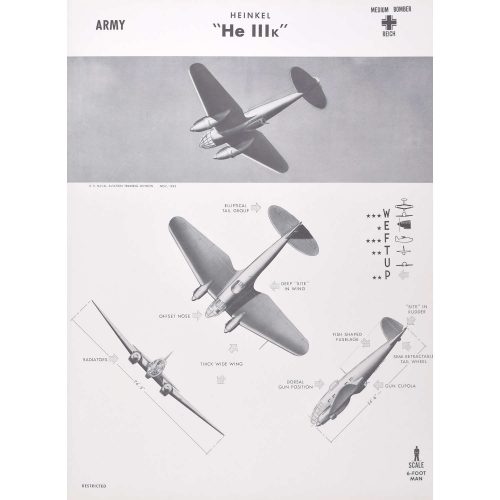
Heinkel "He 111K"
Aeroplane identification poster, published 1942 63 x 47 cm A particularly unusual style of aeroplane identification poster, owing to the very arty images. Most such posters rely on very plain silhouettes, this series - and we have several in this series; view them here - have a much more arty approach to the task with shading and an interesting angle view. The Heinkel He 111 was a German bomber aircraft designed by Siegfried and Walter Günter at Heinkel Flugzeugwerke in 1934. Through development it was described as a "wolf in sheep''s clothing"; due to restrictions placed on Germany after the First World War prohibiting bombers, it masqueraded as a civil airliner, although from conception the design was intended to provide the nascent Luftwaffe with a fast medium bomber. Perhaps the best-recognised German bomber due to the distinctive, extensively glazed "greenhouse" nose of later versions, the Heinkel He 111 was the most numerous Luftwaffe bomber during the early stages of World War II. The bomber fared well until the Battle of Britain, when its weak defensive armament was exposed. Nevertheless, it proved capable of sustaining heavy damage and remaining airborne. As the war progressed, the He 111 was used in a wide variety of roles on every front in the European theatre. It was used as a strategic bomber during the Battle of Britain (and has a prominent role in the film "Battle of Britain"), a torpedo bomber in the Atlantic and Arctic, and a medium bomber and a transport aircraft on the Western, Eastern, Mediterranean, Middle Eastern, and North African Front theatres. The He 111 was constantly upgraded and modified, but became obsolete during the latter part of the war. Condition: generally very good. If you are interested, please email info@manningfineart.co.uk or call us on 07929 749056. -
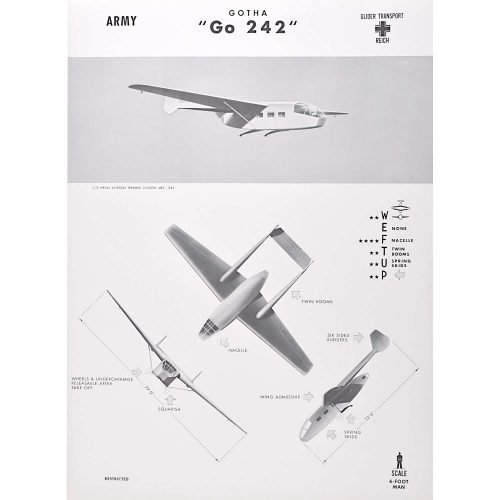
Army Gotha "Go 242"
Aeroplane identification poster, published 1942 63 x 47 cm A particularly unusual style of aeroplane identification poster, owing to the very arty images. Most such posters rely on very plain silhouettes, this series - and we have several in this series; view them here - have a much more arty approach to the task with shading and an interesting angle view. The Gotha Go 242 was a transport glider used by the Luftwaffe during World War II. It was designed by Albert Kalkert in response to the request for a heavy transport glider to replace the DFS 230 which was then in service. The requirement was for a glider capable of carrying 20 fully laden troops, or equivalent cargo. Two prototypes flew in 1941 and the type quickly entered production, with a total of 1,528 being built. In service, Go 242s were towed into the air by Heinkel He 111s or Junkers Ju 52s. Most saw service in the Mediterranean, North Africa and Aegean. Ju 87D-2s had strengthened rear fuselage and combined tailwheel and hook for towing the Go 242. Today, there are two surviving 242s - one in the Musée de la Resistance du Vercors in Valence, France, and the other in the Technik Museum and Luftwaffenmuseum der Bundeswehr in Berlin, Germany. Condition: generally very good. If you are interested, please email info@manningfineart.co.uk or call us on 07929 749056. -
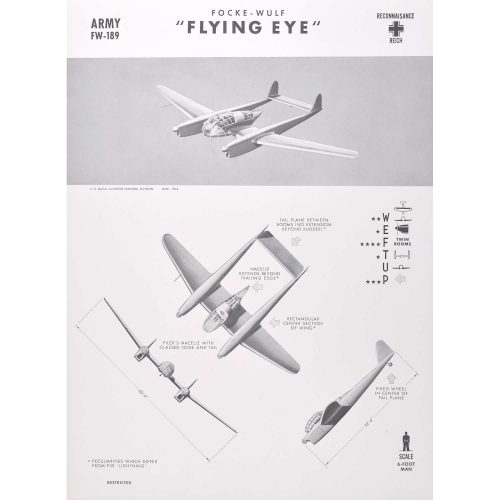
Army FW-189 "Flying Eye"
Aeroplane identification poster, published 1942 63 x 47 cm A particularly unusual style of aeroplane identification poster, owing to the very arty images. Most such posters rely on very plain silhouettes, this series - and we have several in this series; view them here - have a much more arty approach to the task with shading and an interesting angle view. The Focke-Wulf Fw 189 Uhu ("Eagle Owl") was a German twin-engine, twin-boom, three-seat tactical reconnaissance and army cooperation aircraft. It first flew in 1938, entered service in 1940 and was produced until mid-1944. It was nicknamed the “Flying Eye.” Patrolling the vast flatlands of Ukraine and Belarus, the Flying Eye was used extensively on the Eastern Front with great success. It was nicknamed "Rama" ("frame") by Soviet forces, in reference to its distinctive tailboom and stabiliser shapes, which gave it its characteristic quadrangular appearance. Despite its low speed, the Fw 189's manoeuvrability made it a difficult target for attacking Soviet fighters. When attacked, the Flying Eye was often able to out-turn enemy fighters by simply flying in a tight circle. Condition: generally very good. If you are interested, please email info@manningfineart.co.uk or call us on 07929 749056. -
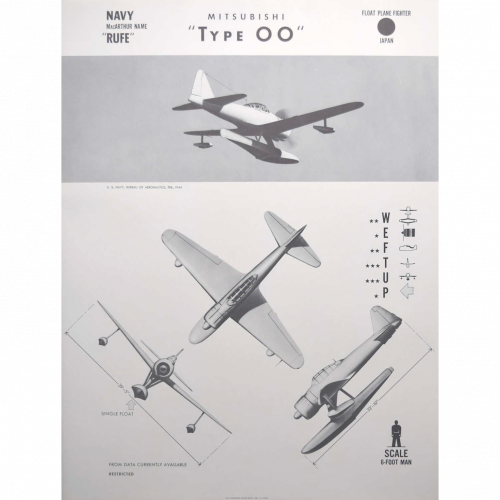
"Rufe" Mitsubishi "Type OO"
Aeroplane identification poster, published 1942 63 x 47 cm A particularly unusual style of aeroplane identification poster, owing to the very arty images. Most such posters rely on very plain silhouettes, this series - and we have several in this series; view them here - have a much more arty approach to the task with shading and an interesting angle view. This Japanese floatplane, known to the Allies as a "Rufe", was developed from the Mitsubishi A6M Type 0 - the famous ''Zero'' figher, mainly to support amphibious operations and defend remote bases. It was based on the A6M-2 Model 11 fuselage, with a modified tail and added floats. A total of 327 were built, including the original prototype. The aircraft was deployed in 1942 and was only used in operations taking place in the Aleutians and Solomon Islands. Such seaplanes were effective in harassing American patrol torpedo boats at night. They could also drop flares to illuminate the American boats which were vulnerable to destroyer gunfire, and depended on cover of darkness. Condition: generally very good. If you are interested, please email info@manningfineart.co.uk or call us on 07929 749056. -
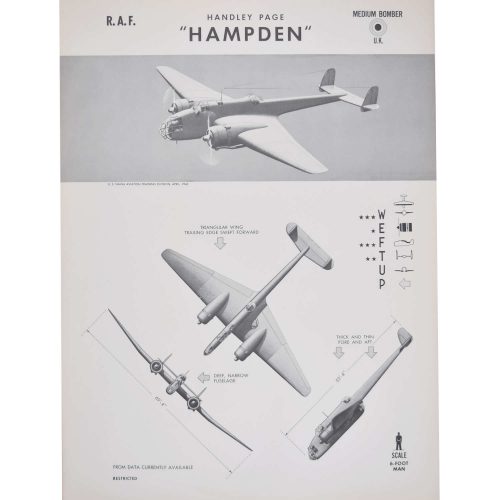
Royal Air Force Handley Page "Hampden" Bomber
Aeroplane identification poster, published 1943 63 x 47 cm A particularly unusual style of aeroplane identification poster, owing to the very arty images. Most such posters rely on very plain silhouettes, this series - and we have several in this series; view them here - have a much more arty approach to the task with shading and an interesting angle view. The Handley Page HP.52 Hampden is a British twin-engine medium bomber that was operated by the Royal Air Force (RAF). It was part of the trio of large twin-engine bombers procured for the RAF, joining the Armstrong Whitworth Whitley and Vickers Wellington. The Hampden was powered by Bristol Pegasus radial engines but a variant known as the Handley Page Hereford had in-line Napier Daggers. The Hampden served in the early stages of the Second World War, bearing the brunt of the early bombing war over Europe, taking part in the first night raid on Berlin and the first 1,000-bomber raid on Cologne. When it became obsolete, after a period of mainly operating at night, it was retired from RAF Bomber Command service in late 1942. By 1943, the rest of the trio were being superseded by the larger four-engined heavy bombers such as the Avro Lancaster. Condition: generally very good. If you are interested, please email info@manningfineart.co.uk or call us on 07929 749056. -
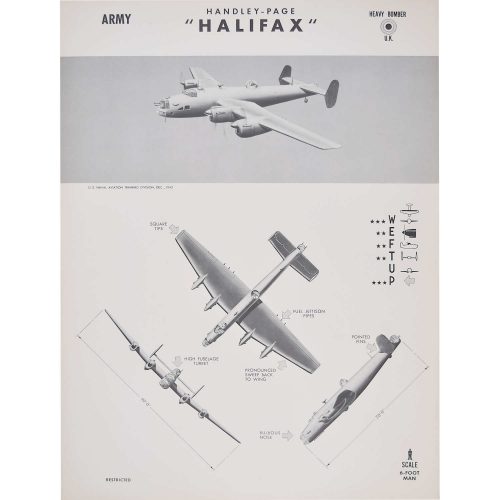
Handley-Page "Halifax"
Aeroplane identification poster, published 1942 63 x 47 cm A particularly unusual style of aeroplane identification poster, owing to the very arty images. Most such posters rely on very plain silhouettes, this series - and we have several in this series; view them here - have a much more arty approach to the task with shading and an interesting angle view. The Halifax bomber was a twin-engined bomber that entered service with the RAF in 1940. Viewed by Arthur ''Bomber'' Harris as inferior to the Lancaster, on account of its smaller payload, the crews preferred it. 1,833 aircraft were lost in service with Bomber Command, across a total of 82,733 operations. Only three survive, one at the Yorkshire Air Museum in Elvington (based on a fuselage that had been in use at a chicken farm following a crash near Stornoway), one at the National Air Force Museum of Canada (which was discovered in 1991 in Norway and subsequently restored), and one at the RAF Museum in London (that crash landed in Norway following an attack on the German battleship Tirpitz; rediscovered in 1971, it has been left unrestored). Condition: generally very good. If you are interested, please email info@manningfineart.co.uk or call us on 07929 749056. -
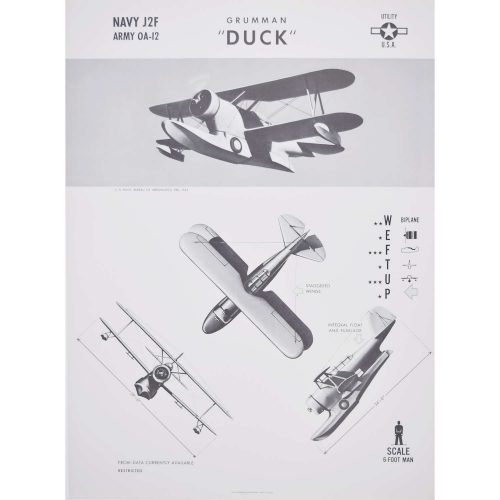
Navy and Army Grumman "Duck"
Aeroplane identification poster, published 1942 63 x 47 cm A particularly unusual style of aeroplane identification poster, owing to the very arty images. Most such posters rely on very plain silhouettes, this series - and we have several in this series; view them here - have a much more arty approach to the task with shading and an interesting angle view. The Grumman J2F Duck was an American single-engine amphibious biplane. It was used by each major branch of the U.S. armed forces from the mid-1930s until just after World War II, primarily for utility and air-sea rescue duties. It was also used by the Argentine Navy, who took delivery of their first J2F in 1937. Apart from general utility and light transport duties, its missions included mapping, reconnaissance, anti-submarine patrol, air-sea rescue work, photographic surveys, and target tug. Condition: generally very good. If you are interested, please email info@manningfineart.co.uk or call us on 07929 749056. -
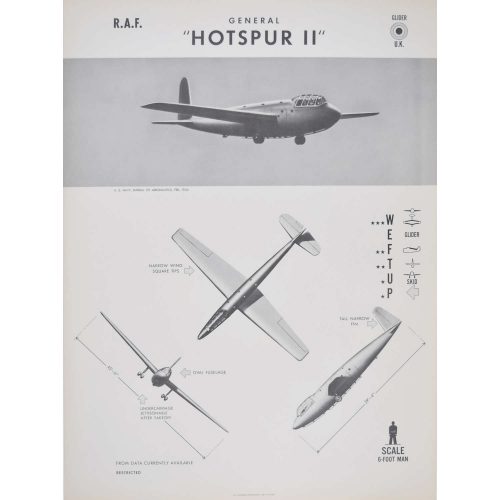
1942 RAF General Hotspur II
Aeroplane identification poster, published 1942 63 x 47 cm A particularly unusual style of aeroplane identification poster, owing to the very arty images. Most such posters rely on very plain silhouettes, this series - and we have several in this series; view them here - have a much more arty approach to the task with shading and an interesting angle view. A particularly unusual style of aeroplane recognition poster, owing to the very arty images. Most such posters rely on very plain silhouettes, this series - and we have several in this series - have a much more arty approach to the task with shading and an interesting angle view. The General Aircraft GAL.48 Hotspur was a military glider designed and built by the British company General Aircraft Ltd during World War II. When the British airborne establishment was formed in 1940 by order of Prime Minister Winston Churchill, it was decided that gliders would be used to transport airborne troops into battle. General Aircraft Ltd were given a contract by the Ministry of Aircraft Production in June 1940 to design and produce an initial glider for use by the airborne establishment, which resulted in the Hotspur. Conceived as an "assault" glider which necessitated a compact design and no more than eight troops carried, tactical philosophy soon favoured larger numbers of troops being sent into battle aboard gliders. Due to this, the Hotspur was mainly relegated to training where it did excel and it became the basic trainer for the glider schools that were formed. The Hotspur was named after Sir Henry Percy, a significant captain during the Anglo-Scottish wars who was also known as "Hotspur". A Hotspur Mark II (HH268) replica is on display at the Museum of Army Flying in Hampshire, England. The front fuselage of a Hotspur was preserved at the Parachute Regiment And Airborne Forces Museum in Aldershot prior to the museum''s 2007 closing, in anticipation of a move to the Imperial War Museum Duxford. Condition: generally very good. If you are interested, please email info@manningfineart.co.uk or call us on 07929 749056. -
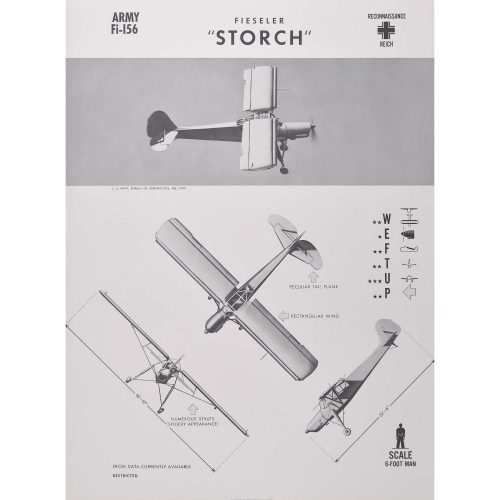
Army Fi-156 Fieseler "Storch"
Aeroplane identification poster, published 1944 63 x 47 cm A particularly unusual style of aeroplane identification poster, owing to the very arty images. Most such posters rely on very plain silhouettes, this series - and we have several in this series; view them here - have a much more arty approach to the task with shading and an interesting angle view. The Fieseler Fi 156 Storch, meaning "stork", was a small German liaison aircraft built by Fieseler before and during World War II. It was notable for its excellent short-takeoff-and-landing performance and low stall speed of 31 mph.The Douglas Skymaster was a four-engine transport aircraft used by the United States Army Air Forces in World War II and the Korean War. Like the Douglas C-47 Skytrain (the Skytrain poster from the same series is also available in our storefront), the Skymaster was derived from a civilian airliner, the Douglas DC-4. The Storch was deployed in all European and North African theatres of World War II. In addition to its liaison function, a number were used to fly a battalion of Infantry Regiment Grossdeutschland behind enemy lines during the invasion of Belgium. In 1943, the Storch played a role in Operation Eiche, the rescue of deposed Italian dictator Benito Mussolini from a boulder-strewn mountain-top near the Gran Sasso. Even though the mountain was surrounded by Italian troops, German commando Otto Skorzeny and 90 paratroopers used gliders to land on the peak and quickly captured it. However, the problem of how to get back off remained. A Focke-Achgelis Fa 223 helicopter was sent, but it broke down en route. Instead, pilot Heinrich Gerlach flew over in a Storch. After Mussolini and Skorzeny had boarded the aircraft, the Storch took off to 250 ft, even though the aircraft was overloaded. A Storch was the last aircraft shot down by the Allies on the Western Front. Condition: generally very good. If you are interested, please email info@manningfineart.co.uk or call us on 07929 749056.

